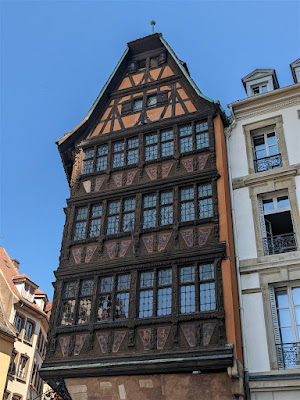Next morning, June 12th, we moved to the P&R and took the bus back into town, mostly to see the great cathedral (next posts), but also to do another Michelin walking tour of the old city.
 |
The German occupation of Strasbourg following the
Franco-Prussian war coincided pretty much with the
years of Art Nouveau, so one doesn't see much of
the beautiful architecture...but there are a few instances |
 |
La Place Broglie...the horse market in the Middle Ages, a central
square in later times, with the grand opera at the end; origin of
the term "horse opera" some say |
 |
The day's caryatids; not too many of these on the half-timbered
beauties |
 |
| Abbatoir of yore |
 |
| Canal scene |
 |
The day's video-shoot; don't know who she was nor why five
camera-persons were required |
 |
| Love the curvy pink arcades |
 |
| Another beautiful building |
 |
| Europe's first iron bridge; so it said |
 |
We stopped for lunch as a restaurant by the adjacent Catholic and Protestant churches; my Alsatian sausages |
 |
| Vicki's schnitzel |
 |
The meal was fine, but the main interest were the
new-to-us golden ground cherries, physalis heterophylla,
served as a side nibble |
 |
Theologian/musicologist/organist/doctor/missionary/polymath
Albert Schweitzer was a native of the Alsace who did time
studying medicine and other things in Strasbourg; authored
The Quest for the Historical Jesus and Reverence for Life;
received the Nobel Peace Prize in 1952 |
 |
An approaching red ant threatened our moment
together, so I smashed it; certain restrictions apply in
my reverence for life |
 |
| Chinese half-timbered look |
 |
The adjoining Catholic and Protestant churches; the latter was closed,
the former not so interesting |
 |
| Another Art Nouveau |
 |
| Galeries Lafayette; used to be the Kaufhaus des Westens (😁) |
 |
| And another Nouveau |
 |
| And an Art Deco; why are they so often movie houses? |
 |
Place Gutenberg; Gutenberg did considerable time in Strasbourg,
where he produced his first printing press; the rest is history, as
they say, and Gutenberg is sometimes referred to as "the man of
the millennium"; little in subsequent human history is imaginable
without him |
 |
Sic transit, Gloria; there is his statue, on Place Gutenberg,
tucked in between a hot dog stand and a merry-go-round |
 |
| Last month's flavor of "Information Age" |
 |
| More curvy streets |
 |
And one final monument I had to find...that of Strasbourg
favorite son Roget de L'Isle, composer of "La Marseillaise,"
which became the French national anthem, known to many
non-Francophones by way of this great movie scene (Major
Strasser and his German buddies, BTW, are singing "De
Wacht am Rhein," which rather neatly ties things together) |



























1 comment:
Ground cherries are new to me.
Post a Comment